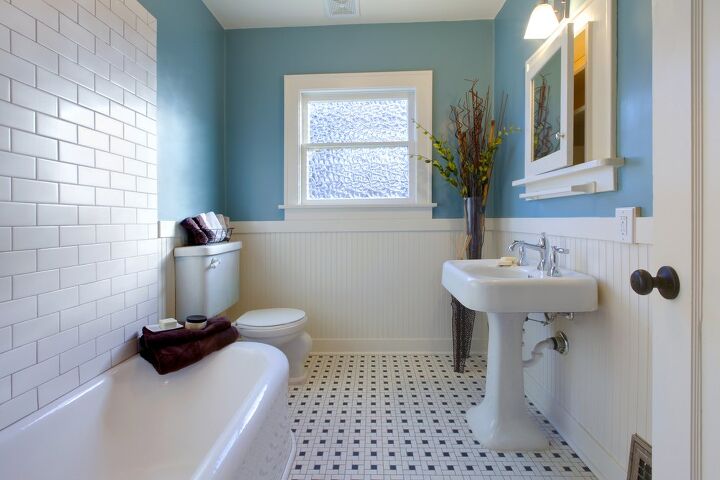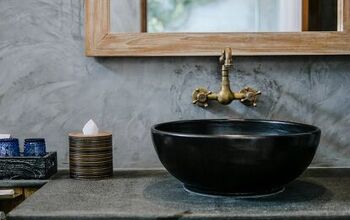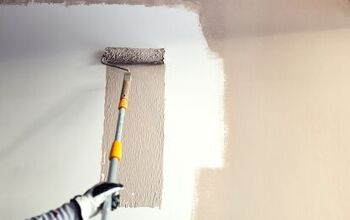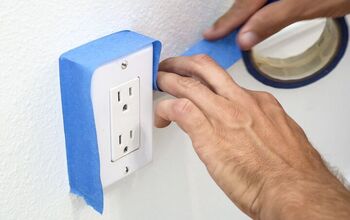Can You Paint A Porcelain Toilet? (Find Out Now!)

As far as bathroom projects go, painting your toilet may not be top of mind. That said, your toilet makes up a large part of your bathroom, and the way it looks will drastically impact the overall aesthetic of the space.
If you’re craving a change, you can paint a porcelain toilet any color you would like, but you need to prep your toilet in a specific way by emptying the water, cleaning the entire toilet, sanding the toilet down, and choosing primers, paints, and finishes that are made specifically to cover porcelain surfaces.
Painting your toilet isn’t like painting your walls or the ceiling or even the cabinets. It requires special care, the right steps, and specific materials, too. Before you start your own painting project, read on to learn more about the process.
Do You Need to Hire a Paint Contractor?
Get free, zero-commitment quotes from pro contractors near you.

Types of Paints for Your Porcelain Toilet
There are two main types of paint you will want to use for a porcelain toilet: latex-based and epoxy-based paints. That said, it’s always the better option to choose materials that are specifically made for porcelain surfaces.
Acrylic Latex Paints
Acrylic-latex paints are eco-friendly, breathable, flexible, washable, and durable among other things. Even with its durability, however, it’s always best to apply an epoxy topcoat after your paint completely dries for enhanced protection.
Epoxy Paints
Typically, epoxy paints are used for touchups or topcoats. They don’t offer as many color options, usually only coming in blacks, whites, or grays. If you choose to paint your porcelain toilet with an epoxy paint, you will not need a topcoat.
Roll-On Painting vs. Spray Painting
Spray painting or painting with a roller are the two best options when painting your porcelain toilet. The ultimate choice is up to your personal preference, but here are the main advantages and disadvantages of both, so you can get a better idea of which method to choose:
Spray Painting Pros
- Faster application times
- More thorough coverage
- More durable coverage
Spray Painting Cons
- Expensive tools, namely the sprayer
- Extensive prep work and clean up
- Cannot stop painting until finished
- Messy
- Uses more paint
Roll-On Painting Pros
- Less expensive overall
- Ideal for smooth surfaces
- Offers more control
- Easier for DIY Projects
Roll-On Painting Cons
- Messy
- Not good for painting in crevices
Steps for Painting a Porcelain Toilet
1. Thoroughly Clean the Toilet
While roll-on paint technically will adhere to a dirty surface, you’ll want to clean your toilet well for best results. Not only will this look better, but it will also ensure no paint chips off and potentially clogs your drain over time. Scrub down the inside and outside of your toilet to ensure it Is completely clean.
2. Remove the Water from the Toilet
After you rinse all the cleaner down the drain, you will have to remove the water from the toilet bowl. You can either do this by turning the water off to prevent your toilet from refilling or by raising the tank float and flushing to remove all excess water.
3. Sand the Surface
To further improve adhesion, you’ll want to sand down the surface of your toilet. For best results, use 120-grit sandpaper. Then, rinse everything off once more as the sanding will add another layer of dust over everything.
4. Wait for the Porcelain to Dry
For this step, you have to be patient for best results. Air drying is always preferred as a towel may leave behind fibers that will negatively impact cleaning. However, you can use a hairdryer if you’re really eager to get started. At this point, you can also tape off any areas that you don’t want to get paint on and lay cloths or newspapers down to protect the floor. You also should open any windows to ensure the area is well ventilated.
5. Select the Right Painting Materials
Porcelain is a very specific material, and it will require specific types of paints. Typically, latex-based and epoxy products are the best options. Whatever you do, veer away from oil-based paints. These will not adhere to the surface, and you’ll find yourself having to repaint sooner rather than later. There are three main things that you will need for a successful painting project:
- Primer: Primers are used to protect the surface and ensure the paint goes on smoothly. Acrylic-latex or epoxy is preferred.
- Paint: Your paint selection will determine what your toilet looks like and how it reflects or absorbs light. As with the primers, you will want to use latex or epoxy paints.
- Finish: The finish will give your paint a sheen—or lack thereof—and help the paint last as long as possible. Semi-gloss or high-gloss finishes will be best for porcelain.
Once you actually begin the process, be sure to tape off any areas that you don’t want to paint. Apply a layer of primer and wait for it to dry. Then, you can begin painting. You may need one or two coats depending on how your paint covers the surface. If you do more than one coat, be sure the paint is completely dry before starting the next one. You can also choose to add an epoxy topcoat.
6. Clean Up Your Space
After everything is completely dry, you can refill your toilet and begin to use it once more. The longer you wait after painting, the better. At the very least, wait a couple hours. If you can manage, leave it to dry overnight. You’ll also want to clean up your paints and materials, get rid of the tape, and get your space back to normal.
Common Color Options for Toilets
You can paint your toilet virtually any color, but there are some general rules you may want to follow for best results. For small bathrooms, consider a lighter toilet that will reflect light and make your space appear larger. On the other hand, you can get away with using darker tones for larger bathrooms as it won’t make it seem as cramped. Here are some popular color choices people choose for their toilets.
White
White is the most common color for toilets. It reflects a lot of light, which will make it an ideal choice for both small and large bathrooms. Plus, white is a very versatile option, which means it can pair well with any color of floor tiles and walls.
Off-White
Off-white toilets will not be as stark of a choice and can help warm up your space. This color is a bit more dynamic than just white and actually helps hide dust and dirt, so you don’t have to clean as often either.
Black
If you have a larger bathroom, a black toilet can make for a great addition. Black absorbs more light, which can make a space appear smaller. More often than not, black toilets are most often installed with black tiles or walls. However, they are also compatible with stone colors or grays.
Gray
Gray toilets can hide a decent amount of dust and are a nice neutral option for any space. Whether you have a big space or a small half bath, a gray toilet will make for a nice addition as it doesn’t not reflect nor absorb light within a space.
Yellow
For a more exciting and unique choice, try yellow! Since yellow toilets are so bright, they reflect a decent amount of light and a warm tone. Like off-white, yellow shades are great for hiding moderate levels dust, which means you won’t have to clean the toilet as often.
Tan
Tan toilets are a bit darker than yellow shades and will complement shades of greens, grays, and off-whites. They are also helpful with hiding dirt and dust, making cleaning and maintenance less intense.
Hiring a Professional Painter
Painting your toilet can easily be a DIY project, but you can also leave it to the professionals. Typically, hiring a painter will be more expensive than painting on your own, but it is the best way to ensure the job is flawless. Even if you do paint on your own, you can get in touch with some contractors and color consultants for pointers on the project.
Related Questions
What are the main types of primers?
There are four main categories of primers for interior painting projects: latex-based, oil-based, shellac, and epoxy sealers. Each is best suited for certain materials, so it’s important to do your research before painting.
What are the main interior paint types?
When it comes to interior paint jobs, you can typically choose between latex-based paints, oil-based paints, or epoxy paints.
What are the types of finishes?
There are five main types of finishes used for painting projects. These include matte, eggshell, satin, semi-gloss, and high-gloss finishes. Matte finishes offer the least sheen while high-gloss finishes provides the most.
Do You Need to Hire a Paint Contractor?
Get free, zero-commitment quotes from pro contractors near you.

Final Thought on Your Painting Project
Changing the color of your toilet can revitalize your space and make the appliance look brand new. You aren’t limited in terms of colors, which means you can transform your space to match your preferred vision.
When painting your toilet, you have to follow specific steps very carefully to ensure you do it correctly. Whether you want to paint the toilet on your own or you want to hire a professional, you can expect a fairly straightforward process with lasting results.

I am a copywriter and editor based in the Las Vegas area with nearly a decade of experience under my belt writing landing pages, cost guides, blog posts, newsletters, case studies, and social media content. I have a degree in Strategic Communication and experience working in both the account and creative spheres. My goal is to always be discovering new interests and bettering myself as a writer and editor along the way.
More by Kerry Souder



























